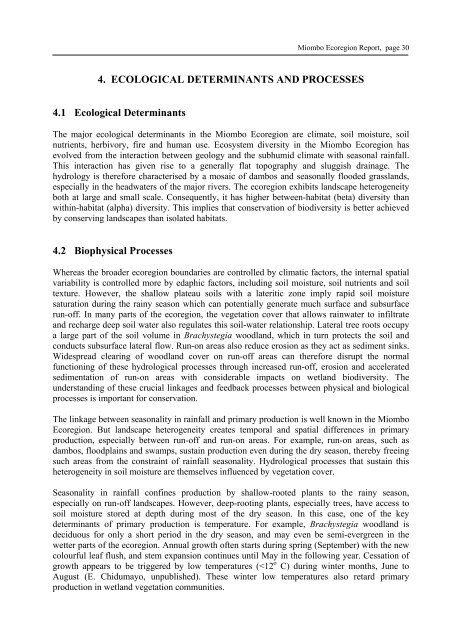Miombo Ecoregion Vision Report - Biodiversity Foundation for Africa
Miombo Ecoregion Vision Report - Biodiversity Foundation for Africa
Miombo Ecoregion Vision Report - Biodiversity Foundation for Africa
You also want an ePaper? Increase the reach of your titles
YUMPU automatically turns print PDFs into web optimized ePapers that Google loves.
<strong>Miombo</strong> <strong>Ecoregion</strong> <strong>Report</strong>, page 30<br />
4. ECOLOGICAL DETERMINANTS AND PROCESSES<br />
4.1 Ecological Determinants<br />
The major ecological determinants in the <strong>Miombo</strong> <strong>Ecoregion</strong> are climate, soil moisture, soil<br />
nutrients, herbivory, fire and human use. Ecosystem diversity in the <strong>Miombo</strong> <strong>Ecoregion</strong> has<br />
evolved from the interaction between geology and the subhumid climate with seasonal rainfall.<br />
This interaction has given rise to a generally flat topography and sluggish drainage. The<br />
hydrology is there<strong>for</strong>e characterised by a mosaic of dambos and seasonally flooded grasslands,<br />
especially in the headwaters of the major rivers. The ecoregion exhibits landscape heterogeneity<br />
both at large and small scale. Consequently, it has higher between-habitat (beta) diversity than<br />
within-habitat (alpha) diversity. This implies that conservation of biodiversity is better achieved<br />
by conserving landscapes than isolated habitats.<br />
4.2 Biophysical Processes<br />
Whereas the broader ecoregion boundaries are controlled by climatic factors, the internal spatial<br />
variability is controlled more by edaphic factors, including soil moisture, soil nutrients and soil<br />
texture. However, the shallow plateau soils with a lateritic zone imply rapid soil moisture<br />
saturation during the rainy season which can potentially generate much surface and subsurface<br />
run-off. In many parts of the ecoregion, the vegetation cover that allows rainwater to infiltrate<br />
and recharge deep soil water also regulates this soil-water relationship. Lateral tree roots occupy<br />
a large part of the soil volume in Brachystegia woodland, which in turn protects the soil and<br />
conducts subsurface lateral flow. Run-on areas also reduce erosion as they act as sediment sinks.<br />
Widespread clearing of woodland cover on run-off areas can there<strong>for</strong>e disrupt the normal<br />
functioning of these hydrological processes through increased run-off, erosion and accelerated<br />
sedimentation of run-on areas with considerable impacts on wetland biodiversity. The<br />
understanding of these crucial linkages and feedback processes between physical and biological<br />
processes is important <strong>for</strong> conservation.<br />
The linkage between seasonality in rainfall and primary production is well known in the <strong>Miombo</strong><br />
<strong>Ecoregion</strong>. But landscape heterogeneity creates temporal and spatial differences in primary<br />
production, especially between run-off and run-on areas. For example, run-on areas, such as<br />
dambos, floodplains and swamps, sustain production even during the dry season, thereby freeing<br />
such areas from the constraint of rainfall seasonality. Hydrological processes that sustain this<br />
heterogeneity in soil moisture are themselves influenced by vegetation cover.<br />
Seasonality in rainfall confines production by shallow-rooted plants to the rainy season,<br />
especially on run-off landscapes. However, deep-rooting plants, especially trees, have access to<br />
soil moisture stored at depth during most of the dry season. In this case, one of the key<br />
determinants of primary production is temperature. For example, Brachystegia woodland is<br />
deciduous <strong>for</strong> only a short period in the dry season, and may even be semi-evergreen in the<br />
wetter parts of the ecoregion. Annual growth often starts during spring (September) with the new<br />
colourful leaf flush, and stem expansion continues until May in the following year. Cessation of<br />
growth appears to be triggered by low temperatures (


